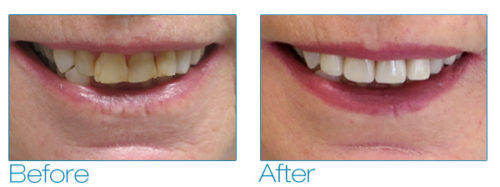
A porcelain veneer is a layer of porcelain placed over a tooth, either to improve the aesthetics of a tooth or to protect the tooth’s surface from damage.

Many people have small teeth resulting in spaces that may not be easily closed by orthodontics. Some people have worn away the edges of their teeth resulting in a prematurely aged appearance, while others may have malpositioned teeth that appear crooked, and do not want to have braces or Invisalign treatment.
Multiple veneers can close these spaces, lengthen teeth that have been shortened by wear, fill the black triangles between teeth caused by gum recession, provide a uniform color, shape, and symmetry, and make the teeth appear straight. Veneers can also be applied to yellow teeth that won’t whiten. In many cases, minimal to no tooth preparation is needed when using porcelain veneers.
A composite bonding may be directly placed (built-up in the mouth) by the dentist in a single appointment. In contrast, a porcelain veneer typically involves two appointments. The porcelain is custom fabricated by a dental lab to the dentist’s specifications. It is then bonded to the tooth with dental cement.
A composite bonding is made of the same material as white filling. It is not as strong as porcelain, but can still last a long time if cared for properly. Like your natural teeth, composite bonding can stain and change colour over time and may require periodic polishing or repair. Porcelain veneers, on the other hand, do not change colour over time and tend to last longer. They are also more expensive than dental bonding.
Typically, dental insurance plans will offer zero or minimal coverage for veneers, but there are exceptions. We can help you determine your coverage when you come in for an appointment or free consultation.





Hi!
I have a moderate dental florosis, what treatments or products would you recommend (other than veneers/ bonding) ? Also, is fluoride free toothpaste/mouthwash a good options for me?
Thank you
Hi H, it really depends on the extent of your fluorosis. Veneers and bonding work well for more severe fluorosis. If the fluorosis is limited to a few teeth, or a few spots, Icon treatment may be an option for you. Icon treatment uses micro-invasive technology that fills and reinforces demineralized enamel without drilling, and it infiltrates up to the first third of dentin. It is used for treating early cavities and has shown to work on some fluorosis cases too. You can learn more about the treatment in the link below.
https://www.dmg-america.com/en/products/product/icon/
If you’re in the area, feel free to book an examination so we can take a look at your teeth and explore the available treatments in more detail.
one of my front teeth seems to be bigger and longer than the other. The problem teeth is also misaligned with my other teeth and the it starts way down below than the others.How can I fix this problem without getting braces?
Hi Aybala, unfortunately I cannot give you an answer without an in-person consultation. Veneers maybe a possibility but it depends on how much longer the tooth is compared to the other teeth. You may have to remove some tooth structure prior to veneer placement. There is also the concern of gum position on this tooth in relation to other teeth. Please visit a dentist for a consultation.
I am trying to decide whether I should have crowns or veneers again for 4 front teeth, where the original veneer has come off or broken at the back! My dentist advised veneers because a crown is too much damage to the existing tooth. I am 61, she is saying I can look at it again later.what would you advise?
Hi Nina, In general, the decision to go with veneers or crowns largely depends on how much of your natural tooth structure is left and if your teeth have had root canal treatments. If the teeth have many large fillings, then a crown may be a better choice. If teeth have never had a root canal treatment, a crown may remove too much tooth structure which could necessitate a root canal treatment. We would also look at factors such as how long the current veneers lasted, any advanced wear on other teeth, the way you are biting, any missing teeth, and if there is history of night time grinding or bruxism.